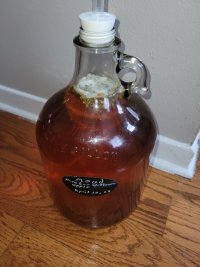MeadMachine
Member
- Joined
- Apr 6, 2022
- Messages
- 10
- Reaction score
- 3
Hi all,
This batch of mead has been fermenting for 6 months. Towards the end the airlock ran out of water due to my negligence and mold has formed on the surface. The mead itself looks fine, though it is very clear compared to the other batch I made alongside it, which is cloudier. I am wondering if this batch is salvageable if I temove the mold and siphon the mead or if I should just toss it as to not risk a bad batch.
Thanks.
This batch of mead has been fermenting for 6 months. Towards the end the airlock ran out of water due to my negligence and mold has formed on the surface. The mead itself looks fine, though it is very clear compared to the other batch I made alongside it, which is cloudier. I am wondering if this batch is salvageable if I temove the mold and siphon the mead or if I should just toss it as to not risk a bad batch.
Thanks.




